NURS 4053 & 3863: Case Study 1 - Fall 2019 - Healthcare Analysis
VerifiedAdded on 2022/12/23
|8
|2401
|56
Case Study
AI Summary
This case study, completed for NURS 4053 and NURS 3863 in Fall 2019, examines interprofessional collaboration in a healthcare setting, focusing on a patient who suffered a submersion injury. The assignment explores the importance of teamwork, communication, and shared goals among healthcare professionals to improve patient outcomes. It covers various aspects of patient care, including parental education on pain assessment and control, specifically addressing pain management strategies for children and the appropriate use of medications like morphine, including dosage calculations and potential adverse effects. The case study also delves into the pathophysiology of brain injury associated with submersion, the prognosis, and the importance of providing social counseling to the parents. Furthermore, it discusses the impact of a tracheostomy tube on the infant's family, the assessment of brain death, and the development of a comprehensive nursing care plan, including interventions to manage aspiration and ensure effective respiratory function. The assignment references several scholarly articles to support the analysis and recommendations.

University
Task
NURS 4053 & NURS 3863
Case Study #1
Fall 2019
Name
Tutor
Date
Task
NURS 4053 & NURS 3863
Case Study #1
Fall 2019
Name
Tutor
Date
Paraphrase This Document
Need a fresh take? Get an instant paraphrase of this document with our AI Paraphraser
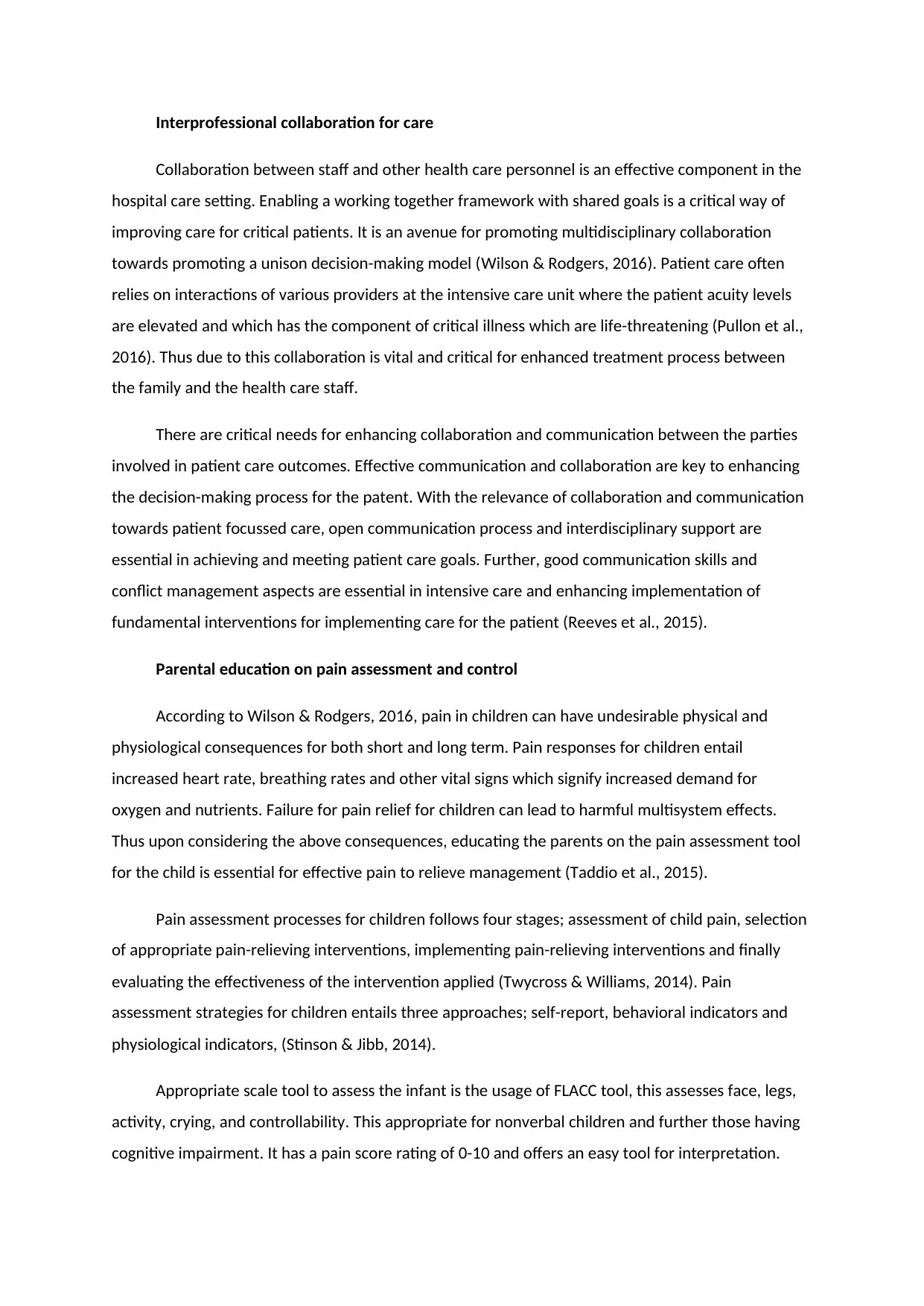
Interprofessional collaboration for care
Collaboration between staff and other health care personnel is an effective component in the
hospital care setting. Enabling a working together framework with shared goals is a critical way of
improving care for critical patients. It is an avenue for promoting multidisciplinary collaboration
towards promoting a unison decision-making model (Wilson & Rodgers, 2016). Patient care often
relies on interactions of various providers at the intensive care unit where the patient acuity levels
are elevated and which has the component of critical illness which are life-threatening (Pullon et al.,
2016). Thus due to this collaboration is vital and critical for enhanced treatment process between
the family and the health care staff.
There are critical needs for enhancing collaboration and communication between the parties
involved in patient care outcomes. Effective communication and collaboration are key to enhancing
the decision-making process for the patent. With the relevance of collaboration and communication
towards patient focussed care, open communication process and interdisciplinary support are
essential in achieving and meeting patient care goals. Further, good communication skills and
conflict management aspects are essential in intensive care and enhancing implementation of
fundamental interventions for implementing care for the patient (Reeves et al., 2015).
Parental education on pain assessment and control
According to Wilson & Rodgers, 2016, pain in children can have undesirable physical and
physiological consequences for both short and long term. Pain responses for children entail
increased heart rate, breathing rates and other vital signs which signify increased demand for
oxygen and nutrients. Failure for pain relief for children can lead to harmful multisystem effects.
Thus upon considering the above consequences, educating the parents on the pain assessment tool
for the child is essential for effective pain to relieve management (Taddio et al., 2015).
Pain assessment processes for children follows four stages; assessment of child pain, selection
of appropriate pain-relieving interventions, implementing pain-relieving interventions and finally
evaluating the effectiveness of the intervention applied (Twycross & Williams, 2014). Pain
assessment strategies for children entails three approaches; self-report, behavioral indicators and
physiological indicators, (Stinson & Jibb, 2014).
Appropriate scale tool to assess the infant is the usage of FLACC tool, this assesses face, legs,
activity, crying, and controllability. This appropriate for nonverbal children and further those having
cognitive impairment. It has a pain score rating of 0-10 and offers an easy tool for interpretation.
Collaboration between staff and other health care personnel is an effective component in the
hospital care setting. Enabling a working together framework with shared goals is a critical way of
improving care for critical patients. It is an avenue for promoting multidisciplinary collaboration
towards promoting a unison decision-making model (Wilson & Rodgers, 2016). Patient care often
relies on interactions of various providers at the intensive care unit where the patient acuity levels
are elevated and which has the component of critical illness which are life-threatening (Pullon et al.,
2016). Thus due to this collaboration is vital and critical for enhanced treatment process between
the family and the health care staff.
There are critical needs for enhancing collaboration and communication between the parties
involved in patient care outcomes. Effective communication and collaboration are key to enhancing
the decision-making process for the patent. With the relevance of collaboration and communication
towards patient focussed care, open communication process and interdisciplinary support are
essential in achieving and meeting patient care goals. Further, good communication skills and
conflict management aspects are essential in intensive care and enhancing implementation of
fundamental interventions for implementing care for the patient (Reeves et al., 2015).
Parental education on pain assessment and control
According to Wilson & Rodgers, 2016, pain in children can have undesirable physical and
physiological consequences for both short and long term. Pain responses for children entail
increased heart rate, breathing rates and other vital signs which signify increased demand for
oxygen and nutrients. Failure for pain relief for children can lead to harmful multisystem effects.
Thus upon considering the above consequences, educating the parents on the pain assessment tool
for the child is essential for effective pain to relieve management (Taddio et al., 2015).
Pain assessment processes for children follows four stages; assessment of child pain, selection
of appropriate pain-relieving interventions, implementing pain-relieving interventions and finally
evaluating the effectiveness of the intervention applied (Twycross & Williams, 2014). Pain
assessment strategies for children entails three approaches; self-report, behavioral indicators and
physiological indicators, (Stinson & Jibb, 2014).
Appropriate scale tool to assess the infant is the usage of FLACC tool, this assesses face, legs,
activity, crying, and controllability. This appropriate for nonverbal children and further those having
cognitive impairment. It has a pain score rating of 0-10 and offers an easy tool for interpretation.
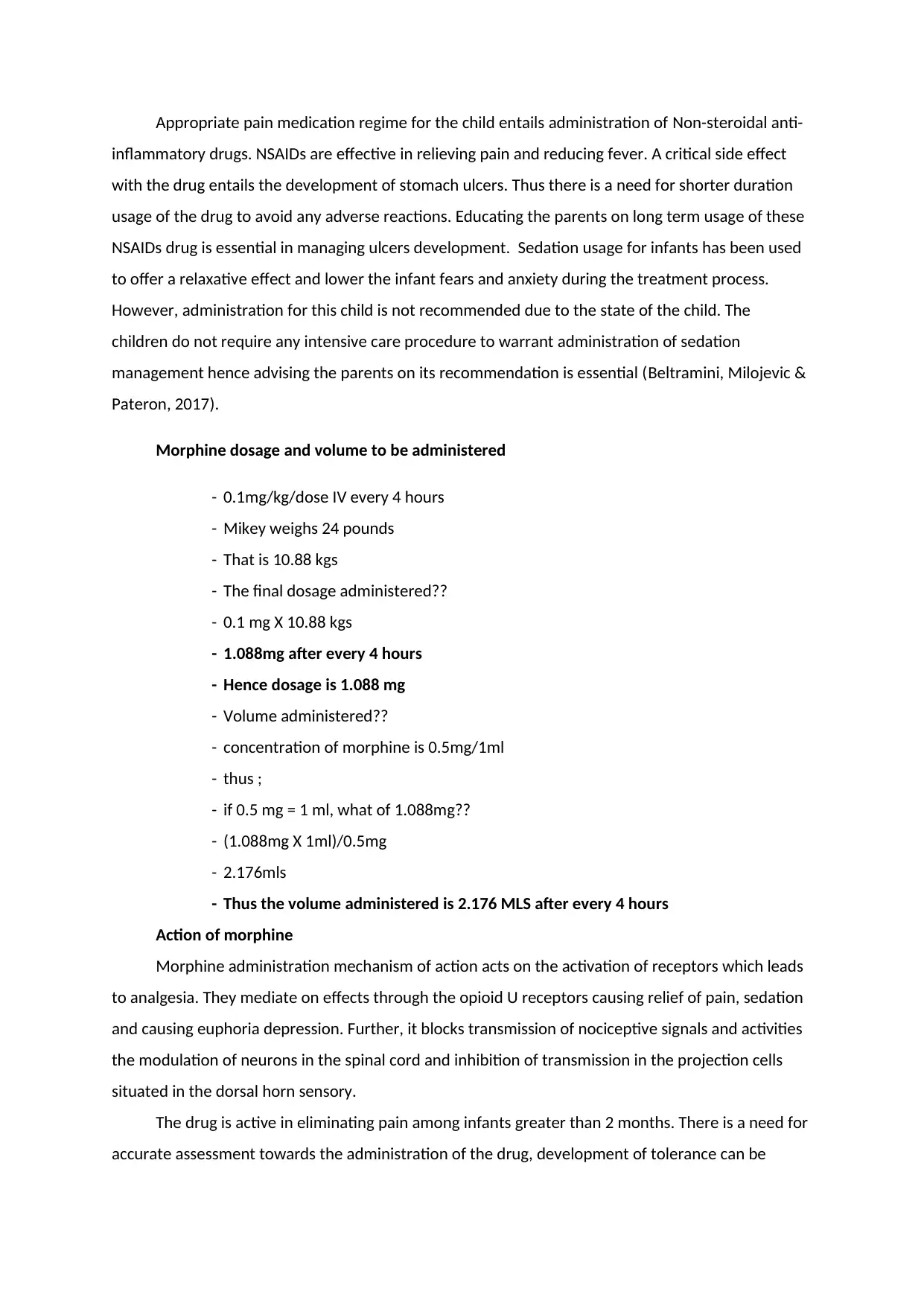
Appropriate pain medication regime for the child entails administration of Non-steroidal anti-
inflammatory drugs. NSAIDs are effective in relieving pain and reducing fever. A critical side effect
with the drug entails the development of stomach ulcers. Thus there is a need for shorter duration
usage of the drug to avoid any adverse reactions. Educating the parents on long term usage of these
NSAIDs drug is essential in managing ulcers development. Sedation usage for infants has been used
to offer a relaxative effect and lower the infant fears and anxiety during the treatment process.
However, administration for this child is not recommended due to the state of the child. The
children do not require any intensive care procedure to warrant administration of sedation
management hence advising the parents on its recommendation is essential (Beltramini, Milojevic &
Pateron, 2017).
Morphine dosage and volume to be administered
- 0.1mg/kg/dose IV every 4 hours
- Mikey weighs 24 pounds
- That is 10.88 kgs
- The final dosage administered??
- 0.1 mg X 10.88 kgs
- 1.088mg after every 4 hours
- Hence dosage is 1.088 mg
- Volume administered??
- concentration of morphine is 0.5mg/1ml
- thus ;
- if 0.5 mg = 1 ml, what of 1.088mg??
- (1.088mg X 1ml)/0.5mg
- 2.176mls
- Thus the volume administered is 2.176 MLS after every 4 hours
Action of morphine
Morphine administration mechanism of action acts on the activation of receptors which leads
to analgesia. They mediate on effects through the opioid U receptors causing relief of pain, sedation
and causing euphoria depression. Further, it blocks transmission of nociceptive signals and activities
the modulation of neurons in the spinal cord and inhibition of transmission in the projection cells
situated in the dorsal horn sensory.
The drug is active in eliminating pain among infants greater than 2 months. There is a need for
accurate assessment towards the administration of the drug, development of tolerance can be
inflammatory drugs. NSAIDs are effective in relieving pain and reducing fever. A critical side effect
with the drug entails the development of stomach ulcers. Thus there is a need for shorter duration
usage of the drug to avoid any adverse reactions. Educating the parents on long term usage of these
NSAIDs drug is essential in managing ulcers development. Sedation usage for infants has been used
to offer a relaxative effect and lower the infant fears and anxiety during the treatment process.
However, administration for this child is not recommended due to the state of the child. The
children do not require any intensive care procedure to warrant administration of sedation
management hence advising the parents on its recommendation is essential (Beltramini, Milojevic &
Pateron, 2017).
Morphine dosage and volume to be administered
- 0.1mg/kg/dose IV every 4 hours
- Mikey weighs 24 pounds
- That is 10.88 kgs
- The final dosage administered??
- 0.1 mg X 10.88 kgs
- 1.088mg after every 4 hours
- Hence dosage is 1.088 mg
- Volume administered??
- concentration of morphine is 0.5mg/1ml
- thus ;
- if 0.5 mg = 1 ml, what of 1.088mg??
- (1.088mg X 1ml)/0.5mg
- 2.176mls
- Thus the volume administered is 2.176 MLS after every 4 hours
Action of morphine
Morphine administration mechanism of action acts on the activation of receptors which leads
to analgesia. They mediate on effects through the opioid U receptors causing relief of pain, sedation
and causing euphoria depression. Further, it blocks transmission of nociceptive signals and activities
the modulation of neurons in the spinal cord and inhibition of transmission in the projection cells
situated in the dorsal horn sensory.
The drug is active in eliminating pain among infants greater than 2 months. There is a need for
accurate assessment towards the administration of the drug, development of tolerance can be
⊘ This is a preview!⊘
Do you want full access?
Subscribe today to unlock all pages.

Trusted by 1+ million students worldwide
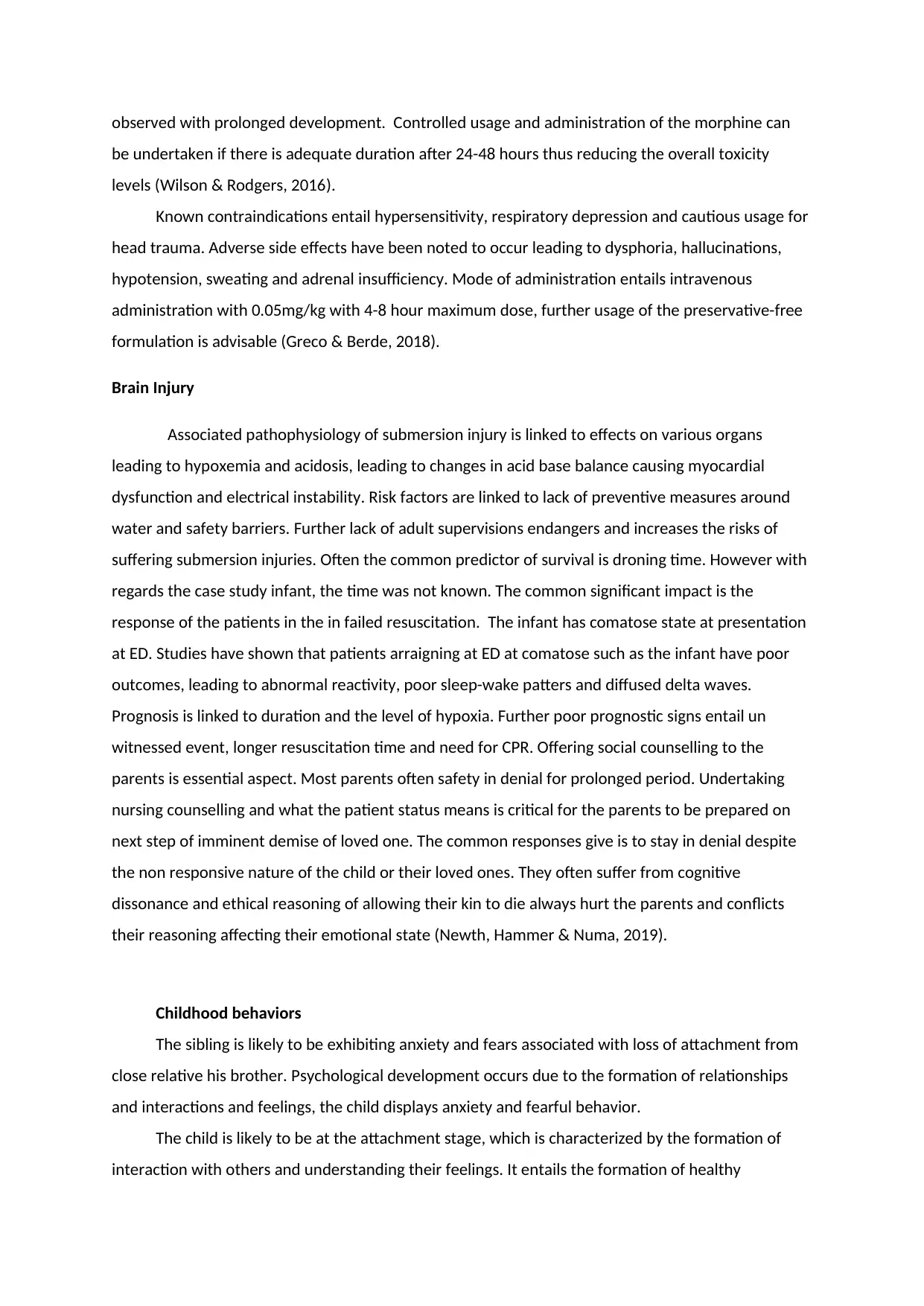
observed with prolonged development. Controlled usage and administration of the morphine can
be undertaken if there is adequate duration after 24-48 hours thus reducing the overall toxicity
levels (Wilson & Rodgers, 2016).
Known contraindications entail hypersensitivity, respiratory depression and cautious usage for
head trauma. Adverse side effects have been noted to occur leading to dysphoria, hallucinations,
hypotension, sweating and adrenal insufficiency. Mode of administration entails intravenous
administration with 0.05mg/kg with 4-8 hour maximum dose, further usage of the preservative-free
formulation is advisable (Greco & Berde, 2018).
Brain Injury
Associated pathophysiology of submersion injury is linked to effects on various organs
leading to hypoxemia and acidosis, leading to changes in acid base balance causing myocardial
dysfunction and electrical instability. Risk factors are linked to lack of preventive measures around
water and safety barriers. Further lack of adult supervisions endangers and increases the risks of
suffering submersion injuries. Often the common predictor of survival is droning time. However with
regards the case study infant, the time was not known. The common significant impact is the
response of the patients in the in failed resuscitation. The infant has comatose state at presentation
at ED. Studies have shown that patients arraigning at ED at comatose such as the infant have poor
outcomes, leading to abnormal reactivity, poor sleep-wake patters and diffused delta waves.
Prognosis is linked to duration and the level of hypoxia. Further poor prognostic signs entail un
witnessed event, longer resuscitation time and need for CPR. Offering social counselling to the
parents is essential aspect. Most parents often safety in denial for prolonged period. Undertaking
nursing counselling and what the patient status means is critical for the parents to be prepared on
next step of imminent demise of loved one. The common responses give is to stay in denial despite
the non responsive nature of the child or their loved ones. They often suffer from cognitive
dissonance and ethical reasoning of allowing their kin to die always hurt the parents and conflicts
their reasoning affecting their emotional state (Newth, Hammer & Numa, 2019).
Childhood behaviors
The sibling is likely to be exhibiting anxiety and fears associated with loss of attachment from
close relative his brother. Psychological development occurs due to the formation of relationships
and interactions and feelings, the child displays anxiety and fearful behavior.
The child is likely to be at the attachment stage, which is characterized by the formation of
interaction with others and understanding their feelings. It entails the formation of healthy
be undertaken if there is adequate duration after 24-48 hours thus reducing the overall toxicity
levels (Wilson & Rodgers, 2016).
Known contraindications entail hypersensitivity, respiratory depression and cautious usage for
head trauma. Adverse side effects have been noted to occur leading to dysphoria, hallucinations,
hypotension, sweating and adrenal insufficiency. Mode of administration entails intravenous
administration with 0.05mg/kg with 4-8 hour maximum dose, further usage of the preservative-free
formulation is advisable (Greco & Berde, 2018).
Brain Injury
Associated pathophysiology of submersion injury is linked to effects on various organs
leading to hypoxemia and acidosis, leading to changes in acid base balance causing myocardial
dysfunction and electrical instability. Risk factors are linked to lack of preventive measures around
water and safety barriers. Further lack of adult supervisions endangers and increases the risks of
suffering submersion injuries. Often the common predictor of survival is droning time. However with
regards the case study infant, the time was not known. The common significant impact is the
response of the patients in the in failed resuscitation. The infant has comatose state at presentation
at ED. Studies have shown that patients arraigning at ED at comatose such as the infant have poor
outcomes, leading to abnormal reactivity, poor sleep-wake patters and diffused delta waves.
Prognosis is linked to duration and the level of hypoxia. Further poor prognostic signs entail un
witnessed event, longer resuscitation time and need for CPR. Offering social counselling to the
parents is essential aspect. Most parents often safety in denial for prolonged period. Undertaking
nursing counselling and what the patient status means is critical for the parents to be prepared on
next step of imminent demise of loved one. The common responses give is to stay in denial despite
the non responsive nature of the child or their loved ones. They often suffer from cognitive
dissonance and ethical reasoning of allowing their kin to die always hurt the parents and conflicts
their reasoning affecting their emotional state (Newth, Hammer & Numa, 2019).
Childhood behaviors
The sibling is likely to be exhibiting anxiety and fears associated with loss of attachment from
close relative his brother. Psychological development occurs due to the formation of relationships
and interactions and feelings, the child displays anxiety and fearful behavior.
The child is likely to be at the attachment stage, which is characterized by the formation of
interaction with others and understanding their feelings. It entails the formation of healthy
Paraphrase This Document
Need a fresh take? Get an instant paraphrase of this document with our AI Paraphraser
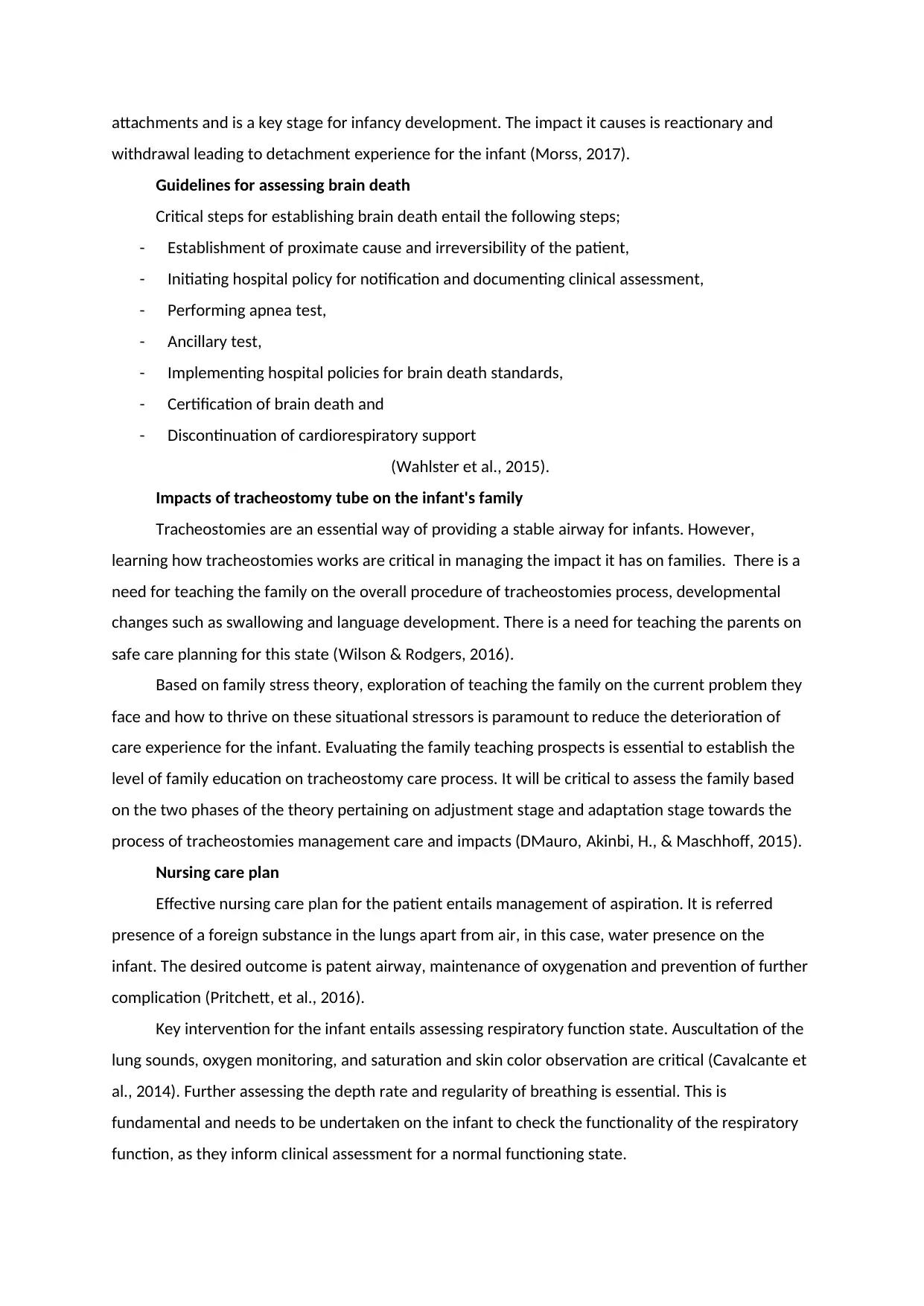
attachments and is a key stage for infancy development. The impact it causes is reactionary and
withdrawal leading to detachment experience for the infant (Morss, 2017).
Guidelines for assessing brain death
Critical steps for establishing brain death entail the following steps;
- Establishment of proximate cause and irreversibility of the patient,
- Initiating hospital policy for notification and documenting clinical assessment,
- Performing apnea test,
- Ancillary test,
- Implementing hospital policies for brain death standards,
- Certification of brain death and
- Discontinuation of cardiorespiratory support
(Wahlster et al., 2015).
Impacts of tracheostomy tube on the infant's family
Tracheostomies are an essential way of providing a stable airway for infants. However,
learning how tracheostomies works are critical in managing the impact it has on families. There is a
need for teaching the family on the overall procedure of tracheostomies process, developmental
changes such as swallowing and language development. There is a need for teaching the parents on
safe care planning for this state (Wilson & Rodgers, 2016).
Based on family stress theory, exploration of teaching the family on the current problem they
face and how to thrive on these situational stressors is paramount to reduce the deterioration of
care experience for the infant. Evaluating the family teaching prospects is essential to establish the
level of family education on tracheostomy care process. It will be critical to assess the family based
on the two phases of the theory pertaining on adjustment stage and adaptation stage towards the
process of tracheostomies management care and impacts (DMauro, Akinbi, H., & Maschhoff, 2015).
Nursing care plan
Effective nursing care plan for the patient entails management of aspiration. It is referred
presence of a foreign substance in the lungs apart from air, in this case, water presence on the
infant. The desired outcome is patent airway, maintenance of oxygenation and prevention of further
complication (Pritchett, et al., 2016).
Key intervention for the infant entails assessing respiratory function state. Auscultation of the
lung sounds, oxygen monitoring, and saturation and skin color observation are critical (Cavalcante et
al., 2014). Further assessing the depth rate and regularity of breathing is essential. This is
fundamental and needs to be undertaken on the infant to check the functionality of the respiratory
function, as they inform clinical assessment for a normal functioning state.
withdrawal leading to detachment experience for the infant (Morss, 2017).
Guidelines for assessing brain death
Critical steps for establishing brain death entail the following steps;
- Establishment of proximate cause and irreversibility of the patient,
- Initiating hospital policy for notification and documenting clinical assessment,
- Performing apnea test,
- Ancillary test,
- Implementing hospital policies for brain death standards,
- Certification of brain death and
- Discontinuation of cardiorespiratory support
(Wahlster et al., 2015).
Impacts of tracheostomy tube on the infant's family
Tracheostomies are an essential way of providing a stable airway for infants. However,
learning how tracheostomies works are critical in managing the impact it has on families. There is a
need for teaching the family on the overall procedure of tracheostomies process, developmental
changes such as swallowing and language development. There is a need for teaching the parents on
safe care planning for this state (Wilson & Rodgers, 2016).
Based on family stress theory, exploration of teaching the family on the current problem they
face and how to thrive on these situational stressors is paramount to reduce the deterioration of
care experience for the infant. Evaluating the family teaching prospects is essential to establish the
level of family education on tracheostomy care process. It will be critical to assess the family based
on the two phases of the theory pertaining on adjustment stage and adaptation stage towards the
process of tracheostomies management care and impacts (DMauro, Akinbi, H., & Maschhoff, 2015).
Nursing care plan
Effective nursing care plan for the patient entails management of aspiration. It is referred
presence of a foreign substance in the lungs apart from air, in this case, water presence on the
infant. The desired outcome is patent airway, maintenance of oxygenation and prevention of further
complication (Pritchett, et al., 2016).
Key intervention for the infant entails assessing respiratory function state. Auscultation of the
lung sounds, oxygen monitoring, and saturation and skin color observation are critical (Cavalcante et
al., 2014). Further assessing the depth rate and regularity of breathing is essential. This is
fundamental and needs to be undertaken on the infant to check the functionality of the respiratory
function, as they inform clinical assessment for a normal functioning state.

Patient management of aspiration is essential s the goal of care is to ensure there is effective
respiration and normalization of breathing. This is further enhanced by improved airway
maintenance. Nursing care goal of enhancing this is crucial as it plays a fundamental role in
enhancing the overall state of the infant (Wilson & Rodgers, 2016).
respiration and normalization of breathing. This is further enhanced by improved airway
maintenance. Nursing care goal of enhancing this is crucial as it plays a fundamental role in
enhancing the overall state of the infant (Wilson & Rodgers, 2016).
⊘ This is a preview!⊘
Do you want full access?
Subscribe today to unlock all pages.

Trusted by 1+ million students worldwide
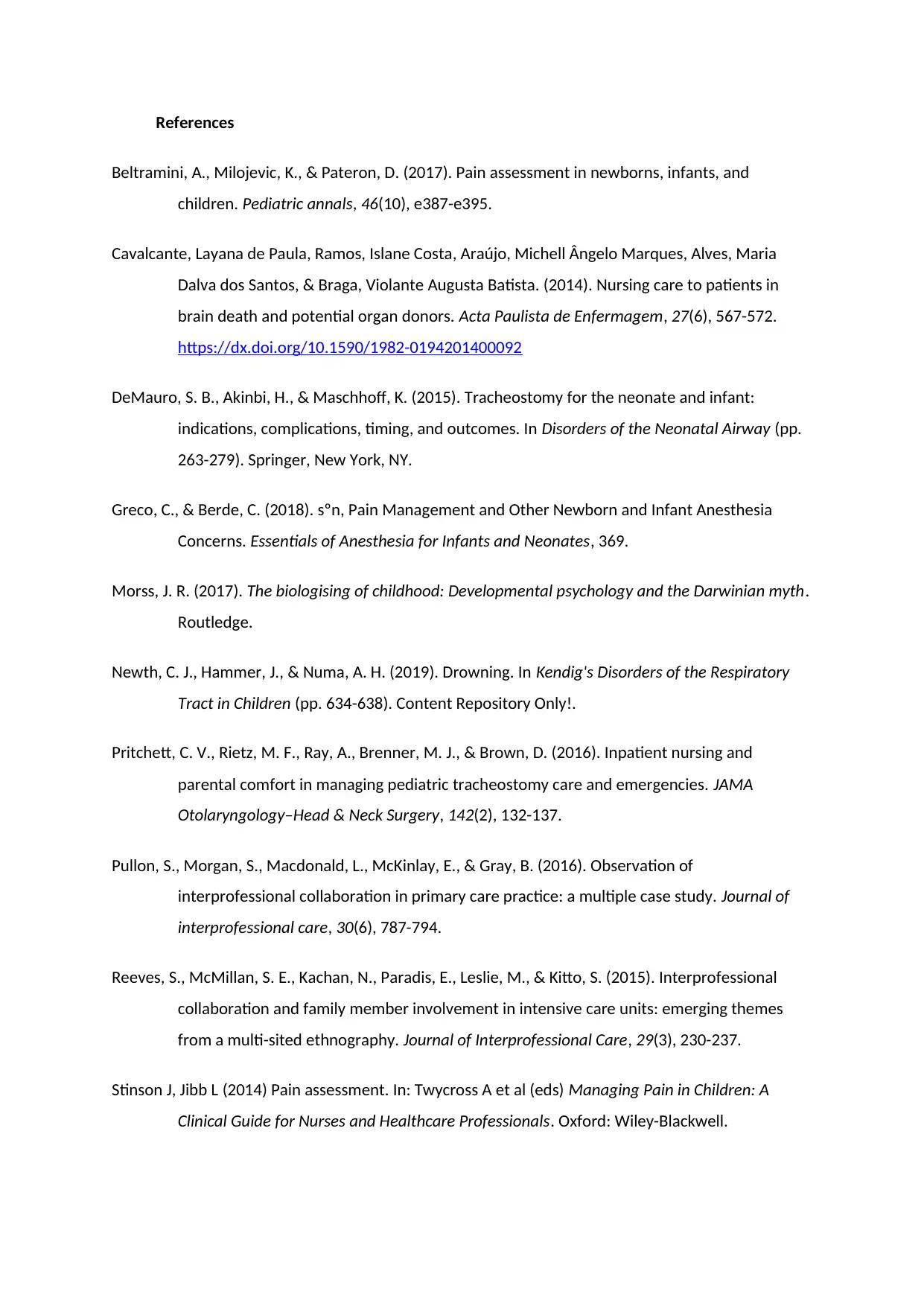
References
Beltramini, A., Milojevic, K., & Pateron, D. (2017). Pain assessment in newborns, infants, and
children. Pediatric annals, 46(10), e387-e395.
Cavalcante, Layana de Paula, Ramos, Islane Costa, Araújo, Michell Ângelo Marques, Alves, Maria
Dalva dos Santos, & Braga, Violante Augusta Batista. (2014). Nursing care to patients in
brain death and potential organ donors. Acta Paulista de Enfermagem, 27(6), 567-572.
https://dx.doi.org/10.1590/1982-0194201400092
DeMauro, S. B., Akinbi, H., & Maschhoff, K. (2015). Tracheostomy for the neonate and infant:
indications, complications, timing, and outcomes. In Disorders of the Neonatal Airway (pp.
263-279). Springer, New York, NY.
Greco, C., & Berde, C. (2018). sºn, Pain Management and Other Newborn and Infant Anesthesia
Concerns. Essentials of Anesthesia for Infants and Neonates, 369.
Morss, J. R. (2017). The biologising of childhood: Developmental psychology and the Darwinian myth.
Routledge.
Newth, C. J., Hammer, J., & Numa, A. H. (2019). Drowning. In Kendig's Disorders of the Respiratory
Tract in Children (pp. 634-638). Content Repository Only!.
Pritchett, C. V., Rietz, M. F., Ray, A., Brenner, M. J., & Brown, D. (2016). Inpatient nursing and
parental comfort in managing pediatric tracheostomy care and emergencies. JAMA
Otolaryngology–Head & Neck Surgery, 142(2), 132-137.
Pullon, S., Morgan, S., Macdonald, L., McKinlay, E., & Gray, B. (2016). Observation of
interprofessional collaboration in primary care practice: a multiple case study. Journal of
interprofessional care, 30(6), 787-794.
Reeves, S., McMillan, S. E., Kachan, N., Paradis, E., Leslie, M., & Kitto, S. (2015). Interprofessional
collaboration and family member involvement in intensive care units: emerging themes
from a multi-sited ethnography. Journal of Interprofessional Care, 29(3), 230-237.
Stinson J, Jibb L (2014) Pain assessment. In: Twycross A et al (eds) Managing Pain in Children: A
Clinical Guide for Nurses and Healthcare Professionals. Oxford: Wiley-Blackwell.
Beltramini, A., Milojevic, K., & Pateron, D. (2017). Pain assessment in newborns, infants, and
children. Pediatric annals, 46(10), e387-e395.
Cavalcante, Layana de Paula, Ramos, Islane Costa, Araújo, Michell Ângelo Marques, Alves, Maria
Dalva dos Santos, & Braga, Violante Augusta Batista. (2014). Nursing care to patients in
brain death and potential organ donors. Acta Paulista de Enfermagem, 27(6), 567-572.
https://dx.doi.org/10.1590/1982-0194201400092
DeMauro, S. B., Akinbi, H., & Maschhoff, K. (2015). Tracheostomy for the neonate and infant:
indications, complications, timing, and outcomes. In Disorders of the Neonatal Airway (pp.
263-279). Springer, New York, NY.
Greco, C., & Berde, C. (2018). sºn, Pain Management and Other Newborn and Infant Anesthesia
Concerns. Essentials of Anesthesia for Infants and Neonates, 369.
Morss, J. R. (2017). The biologising of childhood: Developmental psychology and the Darwinian myth.
Routledge.
Newth, C. J., Hammer, J., & Numa, A. H. (2019). Drowning. In Kendig's Disorders of the Respiratory
Tract in Children (pp. 634-638). Content Repository Only!.
Pritchett, C. V., Rietz, M. F., Ray, A., Brenner, M. J., & Brown, D. (2016). Inpatient nursing and
parental comfort in managing pediatric tracheostomy care and emergencies. JAMA
Otolaryngology–Head & Neck Surgery, 142(2), 132-137.
Pullon, S., Morgan, S., Macdonald, L., McKinlay, E., & Gray, B. (2016). Observation of
interprofessional collaboration in primary care practice: a multiple case study. Journal of
interprofessional care, 30(6), 787-794.
Reeves, S., McMillan, S. E., Kachan, N., Paradis, E., Leslie, M., & Kitto, S. (2015). Interprofessional
collaboration and family member involvement in intensive care units: emerging themes
from a multi-sited ethnography. Journal of Interprofessional Care, 29(3), 230-237.
Stinson J, Jibb L (2014) Pain assessment. In: Twycross A et al (eds) Managing Pain in Children: A
Clinical Guide for Nurses and Healthcare Professionals. Oxford: Wiley-Blackwell.
Paraphrase This Document
Need a fresh take? Get an instant paraphrase of this document with our AI Paraphraser
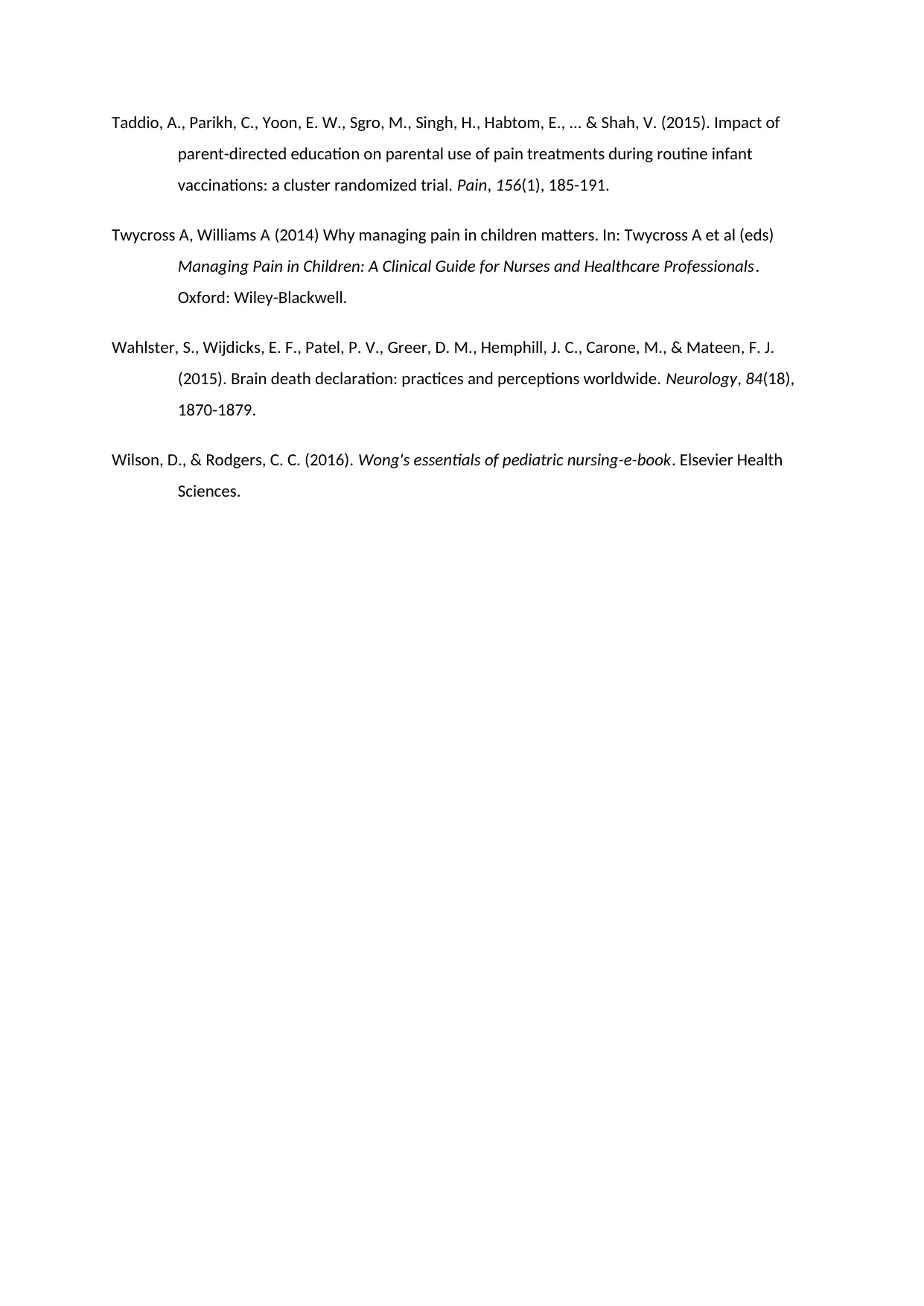
Taddio, A., Parikh, C., Yoon, E. W., Sgro, M., Singh, H., Habtom, E., ... & Shah, V. (2015). Impact of
parent-directed education on parental use of pain treatments during routine infant
vaccinations: a cluster randomized trial. Pain, 156(1), 185-191.
Twycross A, Williams A (2014) Why managing pain in children matters. In: Twycross A et al (eds)
Managing Pain in Children: A Clinical Guide for Nurses and Healthcare Professionals.
Oxford: Wiley-Blackwell.
Wahlster, S., Wijdicks, E. F., Patel, P. V., Greer, D. M., Hemphill, J. C., Carone, M., & Mateen, F. J.
(2015). Brain death declaration: practices and perceptions worldwide. Neurology, 84(18),
1870-1879.
Wilson, D., & Rodgers, C. C. (2016). Wong's essentials of pediatric nursing-e-book. Elsevier Health
Sciences.
parent-directed education on parental use of pain treatments during routine infant
vaccinations: a cluster randomized trial. Pain, 156(1), 185-191.
Twycross A, Williams A (2014) Why managing pain in children matters. In: Twycross A et al (eds)
Managing Pain in Children: A Clinical Guide for Nurses and Healthcare Professionals.
Oxford: Wiley-Blackwell.
Wahlster, S., Wijdicks, E. F., Patel, P. V., Greer, D. M., Hemphill, J. C., Carone, M., & Mateen, F. J.
(2015). Brain death declaration: practices and perceptions worldwide. Neurology, 84(18),
1870-1879.
Wilson, D., & Rodgers, C. C. (2016). Wong's essentials of pediatric nursing-e-book. Elsevier Health
Sciences.
1 out of 8
Related Documents
Your All-in-One AI-Powered Toolkit for Academic Success.
+13062052269
info@desklib.com
Available 24*7 on WhatsApp / Email
![[object Object]](/_next/static/media/star-bottom.7253800d.svg)
Unlock your academic potential
Copyright © 2020–2025 A2Z Services. All Rights Reserved. Developed and managed by ZUCOL.





